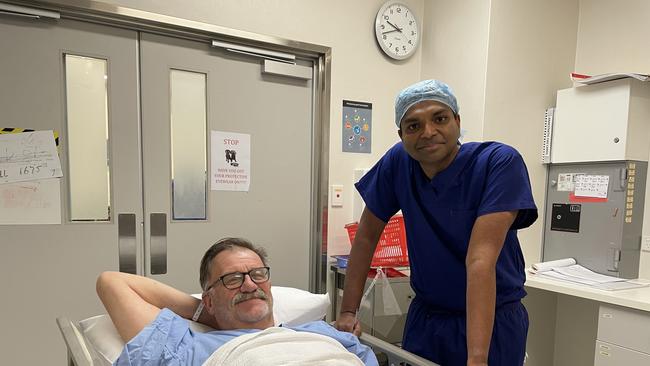New iTind device enabling less invasive and less painful enlarged prostate treatment for half of Victorian men above 50
Victorian men now have access to cutting edge technology that is physically less encroaching and reduces pain for treating enlarged prostates. Find out how:

South East
Don't miss out on the headlines from South East . Followed categories will be added to My News.
A tiny new device has provided relief for Victorian men, as progressive technology enables a less invasive and less painful solution to easing the pain of enlarged prostates.
Performed in Mulgrave for the first time in Victoria on April 20, Associate Professor Sree Appu used the newly developed iTind implant to widen the urethra opening without burning or cutting the prostate tissue.
iTind (temporarily implanted nitinol device) allows doctors to reshape the prostate tissue to enable a wider opening in the urethra for urine to flow freely without having to make a single incision to the patient.

The tiny device made from nitinol functions in a similar way to a stent, however, it is made to be removed.
Fed into the patient through the urethra, the iTind device opens to its full size, and works over seven days to cut of blood supply to the prostate tissue blocking the canal, leaving a clear pathway behind once removed.
Seven days later, the surgeon removes the iTind device, and the patient is left to recover at home.
The day procedure, covered under standard private health insurance, also avoids side effects associated with alternative solutions to enlarged prostates, including other invasive and painful procedures and prescription medications.
Prof Appu said the iTind procedure would reduce down time for patients and holds far less risk to their normal bodily functions.
“It is minimally invasive and allows patients to return to normal life sooner,” he said.
The device also won’t compromise their sexual function.”
John Wriedt was the first Victorian man to undergo the procedure and had the iTind device removed on April 20.
Mr Wriedt decided to undergo the iTind procedure after he received an alternate treatment for enlarged prostates more than five years ago, which had been unsuccessful.
“I’m still getting up five or six times a night,” he said.
“I’m sleep-deprived, it disturbs my partner, and it’s just all around not good.”
Mr Wriedt hoped the iTind would bring him an increased quality of life.
“Sleep is so important, and I hope to be able to sleep better and be more rested,” he said.
“It will mean that I’m a more tolerant and happier person to be around.”
Prof Appu said Mr Wriedt’s procedure was a success, and that he should be fully recovered in a short amount of time.
“The tissue blocking his urethra has been completely cleared,” he said on Thursday.
“This is a great result for the medical industry and for Mr Wriedt.”
The enlargement of the prostate, also known as Benign Prostatic Hyperplasia (BPH), affects 50 per cent of men between 51 and 60 years of age, and increases by 10 per cent with each decade.
BPH causes the prostate to press against the urethra, which leads to chronic lower urinary tract symptoms.
These symptoms can significantly impact quality of life, including issues with urination, frequently needing to visit the toilet, infrequent flow, not being able to sleep through the night and sexual dysfunction.
gemma.scerri@news.com.au


